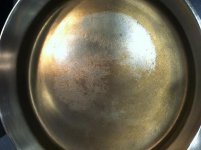I have a very nice Griswold #9 skillet that is finished what I believe is the "Du-Chro" finish; matte on the bottom and sides, polished on top. I appears that the cooking surface might have been plated as well, but then looking at the sides, it is bare iron for about 3/4" of an inch or so up the sides.
It would almost appear that the cooking surface was coated at well, but then again, it stripped down to bare iron in other spots.
What I am trying to decide is if the cooking surface was originally plated, or left bare. And if it was left bare, how can I strip off what looks to be some sort of plating?
I hope this is clear as mud!
Edited to add - I took this picture just as I applied the first coat of Crisco, just prior to putting it back into the over.
It would almost appear that the cooking surface was coated at well, but then again, it stripped down to bare iron in other spots.
What I am trying to decide is if the cooking surface was originally plated, or left bare. And if it was left bare, how can I strip off what looks to be some sort of plating?
I hope this is clear as mud!
Edited to add - I took this picture just as I applied the first coat of Crisco, just prior to putting it back into the over.
Attachments
Last edited:

